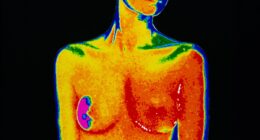
Individuals who experience clustered migraines are more likely to suffer from heart attacks or cardiac rhythm abnormalities. This article uncovers the connection between heart health and migraine.
Heart health and migraine, seemingly disparate health conditions, have emerged as significant subjects of interest in the medical field. While their connection may not be immediately apparent, recent research has shed light on a potential link between these two disorders. In this article, we embark on a journey to investigate the intriguing relationship between heart health and migraine, delving into the underlying mechanisms, shared risk factors, and potential implications for patient therapy.
A recent study has revealed a startling revelation: individuals who experience cluster migraine are approximately twice as likely to suffer from heart attacks or cardiac rhythm abnormalities, such as atrial fibrillation and atrial flutter. Notably, the study found a particularly strong association between migraines accompanied by auras and the incidence of heart attacks, mirroring a similar pattern seen in strokes.
Migraine: Unravelling the Enigmatic Nature of This Neurological Disorder
Migraine is a neurological illness characterised by recurrent episodes of moderate to severe headaches, as well as other symptoms such as nausea, light and sound sensitivity, and vision abnormalities. Although the actual cause of migraines is unknown, various triggers, such as hormone changes, specific meals, stress, and environmental variables, have been found.
Cluster migraine, also referred to as cluster headache, is a rare form of migraine that affects a small percentage of the population. It is characterized by severe, excruciating pain typically localized around one eye or temple, often described as piercing or burning. The pain occurs in clusters, with episodes lasting from weeks to months, followed by periods of remission. The excruciating pain experienced during an attack is often described as one of the most severe forms of pain known to medical science. Alongside the pain, individuals may also experience additional symptoms, such as redness or swelling around the affected eye, drooping eyelid, nasal congestion, and excessive tearing.
The episodic nature of cluster migraine sets it apart from other migraine subtypes, presenting unique challenges in both diagnosis and management. While the exact cause of cluster migraine remains unknown, researchers believe that abnormalities in the hypothalamus, a region of the brain responsible for regulating various physiological functions, play a crucial role.
Heart Health and Migraine: A Hidden Heart-Mind Connection
There is a bidirectional association between migraine and cardiovascular health, according to research. Migraine sufferers have an increased chance of acquiring cardiovascular disorders such as heart attacks, strokes, and irregular heart rhythms. Individuals with pre-existing cardiac issues, on the other hand, are more likely to suffer from migraines. This intriguing correlation has prompted scientists to look into possible underlying mechanisms that link these two illnesses.
Shared Risk Factors In Heart Disease And Migraine
Are shared risk factors the missing puzzle piece in understanding the heart-migraine connection? Shared risk factors can indeed provide valuable insights into the complex relationship between heart health and migraine. Several lifestyle and physiological factors, such as obesity, high blood pressure, smoking, physical inactivity, and high cholesterol levels, contribute to both heart disease and migraine. By identifying and addressing these shared risk factors, healthcare providers can not only improve heart health but also potentially alleviate migraine symptoms. Understanding the connection between these risk factors and their impact on both conditions is crucial in developing comprehensive and effective strategies for prevention, management, and patient care.
Common Threads Linking Heart Health and Migraine
Vascular dysfunction, defined as irregularities in blood vessels, is a common component of migraines and heart disease. Endothelial dysfunction, a disorder in which the inner lining of blood arteries fails to function properly, has been found in migraine sufferers. Endothelial dysfunction can result in decreased blood flow and increased inflammation, which can contribute to the development of cardiovascular diseases. Furthermore, inflammation, both systemic and localised, has been linked to the pathogenesis of both disorders.
READ RELATED: 11 Exercises Women Should Do Every Day for Weight Loss
Shared Pathways and Genetic Factors May Help Understand The Heart-Migraine Link
Certain biochemical pathways and hereditary variables may contribute to both heart disease and migraines, according to mounting data. The renin-angiotensin system, which regulates blood pressure and fluid balance, is one such mechanism. Both disorders have been linked to dysregulation of this system. Furthermore, certain genetic variants that enhance the incidence of migraines and cardiovascular disease have been identified.
Recognizing Heart-Migraine Connection May Transform Patient Care and Improve Health Outcomes
Recognizing the link between cardiovascular health and migraines has significant implications for patient care. Migraine sufferers should be tested for cardiovascular risk factors, and vice versa. Healthcare practitioners should take a holistic strategy to treating both illnesses at the same time. Lifestyle changes, pharmaceutical therapies, and preventative methods aiming at lowering cardiovascular risk and migraine frequency can significantly improve patient outcomes.
Henceforth, relationship between heart health and migraines is an intriguing topic of study. While more research is needed to fully understand the mechanisms at work, evidence suggests that common risk factors, vascular dysfunction, inflammation, and genetic variables all play important roles. Recognizing and addressing the link between these two disorders will enable more effective preventative and management techniques, ultimately enhancing patients’ overall health and well-being.
The article is contributed by Dr. Shiva Kumar R. Senior Consultant Neurology & Epileptology at Sakra World Hospital.
Total Wellness is now just a click away.
Follow us on
window.addEventListener(‘load’, (event) => {
// $(document).ready(function(){
$(‘#commentbtn’).on(“click”,function(){
(function(d, s, id) { var js, fjs = d.getElementsByTagName(s)[0]; if (d.getElementById(id)) return; js = d.createElement(s); js.id = id; js.src = “//connect.facebook.net/en_US/sdk.js#xfbml=1&version=v2.3”; fjs.parentNode.insertBefore(js, fjs);}(document, ‘script’, ‘facebook-jssdk’));
$(“.cmntbox”).toggle();
});
// });
});






